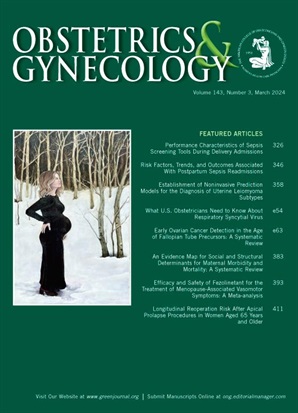Canadian Management of Serous Tubal Intraepithelial Carcinoma.
IF 4.7
2区 医学
Q1 OBSTETRICS & GYNECOLOGY
引用次数: 0
Abstract
OBJECTIVE To assess the management and outcomes of patients diagnosed with an isolated serous tubal intraepithelial carcinoma lesion across Canada. METHODS This retrospective study included consecutive patients with an isolated serous tubal intraepithelial carcinoma lesion diagnosed between 2006 and 2020 at 15 Canadian centers. Cases underwent multicenter panel pathology review. RESULTS Of 107 patients, 41 serous tubal intraepithelial carcinoma cases (38.3%) were identified at prophylactic surgery for germline pathogenic variants, 36 (33.6%) at surgery for suspicion of malignancy, and 30 (28.0%) at surgery for benign conditions. Treatment groups included observation (n=62, 57.9%), staging surgery (n=35, 32.7%), and adjuvant chemotherapy (n=10, 9.3%). Median follow-up was 55.5 months (interquartile range 30.26-82.07 months). Overall, nine patients developed high-grade serous carcinoma. The cumulative incidence of high-grade serous carcinoma was not significantly different between treatment groups (P=.181); however, no patient treated with chemotherapy developed high-grade serous carcinoma. The cumulative incidence of high-grade serous carcinoma was 1.1% (95% CI, 0.1-5.3%) at 2 years and 5.7% (95% CI, 1.8-13.1%) at 5 years. No significant predictive factors were found on univariate analysis. After multicenter pathology review of 59 cases (55.1%), consensus diagnosis was reached: 45 (76.3%) with serous tubal intraepithelial carcinoma, three (5.1%) with serous tubal intraepithelial lesion, seven (11.9%) with high-grade serous carcinoma, and two (3.4%) with normal tissue. Of the cases reviewed, only 1 of 45 patients (2.2%) with confirmed serous tubal intraepithelial carcinoma developed high-grade serous carcinoma at 73 months, indicating a 5-year cumulative incidence of cancer of 2.6% (95% CI, 0.2-11.7). CONCLUSION Management of serous tubal intraepithelial carcinoma varied across centers. The 5-year cumulative incidence of high-grade serous carcinoma after isolated serous tubal intraepithelial carcinoma was 5.7%, consistent with recent literature. However, multicenter pathology review revealed initial underdiagnosed high-grade serous carcinoma, and 5-year cumulative incidence of high-grade serous carcinoma after confirmed serous tubal intraepithelial carcinoma decreased to 2.6%, underscoring the importance of diagnostic confirmation by expert pathologists to guide accurate management.加拿大浆液性输卵管上皮内癌的处理。
目的评估加拿大孤立性浆液性输卵管上皮内癌的治疗和预后。方法:本回顾性研究纳入了2006年至2020年在加拿大15个中心连续诊断的孤立性浆液性输卵管上皮内癌患者。病例行多中心病理检查。结果107例患者中,41例浆液性输卵管上皮内癌(38.3%)因生殖系致病变异而行预防性手术,36例(33.6%)因怀疑恶性肿瘤而行手术,30例(28.0%)因良性病变而行手术。治疗组包括观察组(n=62, 57.9%)、分期手术组(n=35, 32.7%)、辅助化疗组(n=10, 9.3%)。中位随访时间为55.5个月(四分位数间隔30.26 ~ 82.07个月)。总体而言,9例患者发展为高级别浆液性癌。两组间高级别浆液性癌的累积发病率无显著差异(P= 0.181);然而,没有接受化疗的患者发展为高级别浆液性癌。2年时,高级别浆液性癌的累积发病率为1.1% (95% CI, 0.1-5.3%), 5年时为5.7% (95% CI, 1.8-13.1%)。单因素分析未发现显著的预测因素。对59例(55.1%)患者进行多中心病理检查,一致诊断为:浆液性输卵管上皮内癌45例(76.3%),浆液性输卵管上皮内病变3例(5.1%),高级别浆液性癌7例(11.9%),正常组织2例(3.4%)。在回顾的病例中,确诊浆液性输卵管上皮内癌的45例患者中只有1例(2.2%)在73个月时发展为高级别浆液性癌,表明5年累积癌症发病率为2.6% (95% CI, 0.2-11.7)。结论各中心对浆液性输卵管上皮内癌的处理存在差异。孤立性浆液性输卵管上皮内癌后的5年累积高级别浆液性癌发病率为5.7%,与近期文献一致。然而,多中心病理回顾显示,最初未确诊的高级别浆液性癌,确诊浆液性输卵管上皮内癌后的5年累积高级别浆液性癌发病率降至2.6%,强调了病理学专家诊断确认对指导准确治疗的重要性。
本文章由计算机程序翻译,如有差异,请以英文原文为准。
求助全文
约1分钟内获得全文
求助全文
来源期刊

Obstetrics and gynecology
医学-妇产科学
CiteScore
11.10
自引率
4.20%
发文量
867
审稿时长
1 months
期刊介绍:
"Obstetrics & Gynecology," affectionately known as "The Green Journal," is the official publication of the American College of Obstetricians and Gynecologists (ACOG). Since its inception in 1953, the journal has been dedicated to advancing the clinical practice of obstetrics and gynecology, as well as related fields. The journal's mission is to promote excellence in these areas by publishing a diverse range of articles that cover translational and clinical topics.
"Obstetrics & Gynecology" provides a platform for the dissemination of evidence-based research, clinical guidelines, and expert opinions that are essential for the continuous improvement of women's health care. The journal's content is designed to inform and educate obstetricians, gynecologists, and other healthcare professionals, ensuring that they stay abreast of the latest developments and best practices in their field.
 求助内容:
求助内容: 应助结果提醒方式:
应助结果提醒方式:


